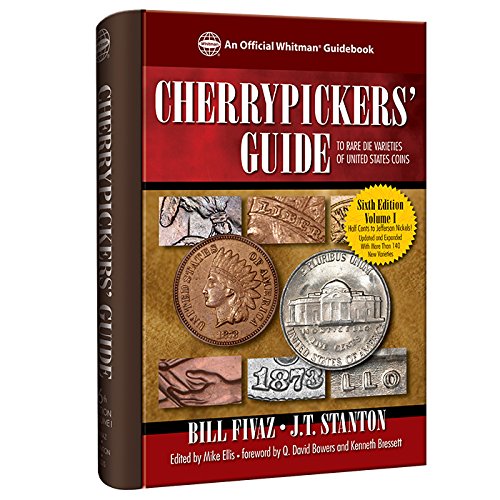Jun 14, 2022 | Carson City, coins, dollar, errors, grading, GSA, Morgan
Life can be confusing. One of those confusions is when people do something for reasons that are not obvious. Then when the people were asked why they did not offer any answers.

1882-CC GSA “Grand Snake Morgan Dollar Struck 15% Off Center graded NGC MS 65 (Image courtesy of NGC)
The coin is fascinating in that it looks stunning, survived for so long to be part of the GSA Hoard, and the original owner purchased the coin for $30 in 1972. But that is not what makes this coin a curiosity.
Rather than NGC applying the tamper-evident label that NGC wraps around the GSA holder, NGC placed the entire GSA holder in one of their Mega Holders.
According to NGC’s website, the Mega Holder can hold a coin as large as 180 mm (about 7-inches) in diameter and 28 mm (about 1.1-inches) thick. The NGC holder appears to be three times the size of the GSA holder.
Understandably, a collector would send a coin of this significance to NGC for authentication and grading. But why did NGC have to slab the entire GSA holder? The coin is 38.1 mm in diameter (less than 1-inch) and is in a holder for a coin seven times its size. The coin, which should be the central focus, appears lost.
I tried to ask NGC about their decision to slab the entire GSA holder, and the response I received referred me back to the article that does not discuss the decision. There must be a reason other than “this is what the client wanted.” Even if NGC does not want to answer the question, I want to see the coin in person.
Sep 18, 2021 | auction, errors, fun
Today marks the third weekend of the college football season. Sunday is the second weekend of the NFL season. Autumn begins on Wednesday, and there are 43 days until Halloween.
Want to celebrate Halloween in style? Why not bid on an encapsulated cricket!
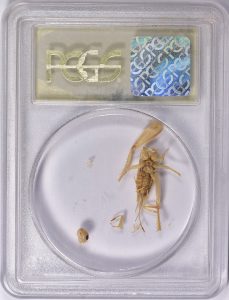
Slabbed cricket up for auction from the Collection of Fred Weinberg at GreatCollection Auctions (GreatCollection photo)
According to GreatCollections, “back in the 1990s, there was a cricket disturbing the coin graders at PCGS, until one of them caught it and put it in a slab. It was then the subject at a high level meeting of graders where it was decided to give it to error expert Mr. Fred Weinberg.”
It was recently on display at the last World’s Fair of Money.
After more than 20 years, the carcass is a bit fragile. If nothing else, it proves that the slabs are not air-tight. If the slabs were air-tight, the carcass would not deteriorate.
Although the slab does not have a grade, the folks at GreatCollections said that they “would grade the cricket a solid MS-65 Full Head (Detached).”
As of Friday, September 17, the high bid is $2,900 with 54 bids. The auction will end on Halloween at 4:05 PM PST.
What started as a joke is now a fun part of numismatic lore.
Here’s an interview from CoinWeek with Fred Weinberg talking about the “error”:
Feb 23, 2020 | Australia, coins, errors, news
Aussie coin collectors are scouring through their change, looking for a Mule Dollar.
A woman from Melbourne found an Australian dollar coin where the obverse was different from the others. The lettering and portrait were smaller and had a doubled rim. The story went viral on social media.

Comparing the $1 mule on the left to a regular $1 coin on the right
(Image courtesy of the Australian Coin Blog)
The mule was first discovered in 2003, according to the Australian Coin Blog. Known as the “2000 $1 / 10 cent Mules,” the coins were sent to Perth for use in the casinos. At the time, the collectors and other interested people withdrew thousands of dollar coins from casinos and banks looking for the coin.
Australian coin experts suspect that the error occurred when someone accidentally installed the wrong obverse die into the coin press. Rather than using the die to strike the 25 mm dollar coin, the die that should strike the 23.6 10 cents coin was used. The 1.4 mm difference gives the impression of a doubled edge on the coin.
There are no statistics as to how many of these coins are in circulation. Considering they keep appearing every few years, the discovery causes a frenzy, especially amongst casual observers. It would be like someone finding an “extra leaf” Wisconsin quarter.
And now the news…

February 17, 2020
Presidents on money Since Presidents Day is Monday, we thought we would see how presidents stack up against each other in money.

→ Read more at
eastbaytimes.com

February 18, 2020
A ceremony has been held in American Samoa to mark the launch of a coin honouring the territory's national park. The new US coin with an image of a Samoan fruit bat. Photo: U.S.

→ Read more at
rnz.co.nz

February 21, 2020
A Berlin court sentenced three men on Thursday over the 2017 theft of a gigantic gold coin from a city museum. The coin, dubbed the "Big Maple Leaf," weighed roughly 100 kilograms (220 pounds) and had an estimated value of €3.75 million ($4.05 million).

→ Read more at
dw.com

February 21, 2020
An ultra-rare U.S $5 coin minted during the California Gold Rush is set to sell for millions when it goes up for auction in Baltimore next month. The legendary 1854-S Liberty Head ‘Half Eagle’ is one of only three examples known to exist, and has been described as “one of the most famous rarities in the world of American coins”.

→ Read more at
news.justcollecting.com

February 21, 2020
A rare $1 coin could be worth thousands of dollars thanks to one minor mistake. The Royal Australian Mint made an error when making 'Mule Dollar' coins – a small number of $1 coins from the year 2000 that were made using the wrong print.

→ Read more at
dailymail.co.uk

February 21, 2020
Lifestyle Archaeologists. A Houston neighborhood called ‘The Scorpion.’

→ Read more at
houstonchronicle.com
Jan 17, 2019 | advice, coins, counterfeit, errors
 One of the more popular collector series is the Indian Head or Buffalo Nickels. Designed by James Earl Fraser, a student of Augustus Saint-Gaudens, this design was a continuation of President Theodore Roosevelt’s “pet crime” to change the look of the nation’s coinage.
One of the more popular collector series is the Indian Head or Buffalo Nickels. Designed by James Earl Fraser, a student of Augustus Saint-Gaudens, this design was a continuation of President Theodore Roosevelt’s “pet crime” to change the look of the nation’s coinage.
Introduced in 1913, the coin features a right-facing Indian head (now called a Native American head). Although there have been claims by several tribal chiefs that they were the model, Fraser’s notes suggest the image was created using the features of several men.
The reverse features the image of a buffalo, which in reality is a North American bison. The 38 different types of buffaloes live in Africa and feature larger horns similar to a longhorn steer. Most are domesticated and are raised like cattle is in the United States. Bison are largely wild animals native to the western hemisphere. Aside from their shorter horns, they have beards hanging from their chin and heavier coats that allow them to survive in colder climates.
But that has not stopped people from referring to the coin as a Buffalo nickel. It is a design so popular that when it has been used in coinage, the available supply usually sells out.
War Nickels
Before I receive a deluge of email, the Jefferson nickels struck from 1942 through 1945 were struck on a planchet made from .560 copper, .350 silver, and .090 manganese and features a large mint mark over the image on Monticello on the reverse. This was done to reduce the use of copper and nickel needed for the war effort.
Like every five-cents coin made since the introduction of the 1883 Liberty Head or “V” nickel, the planchet is made from an alloy of 75-percent copper and 25-percent nickel. Most vending machines will not be able to tell the difference between a Buffalo nickel and a Jefferson nickel.
The coin’s ability to be used in vending machines and how a worn coin could pass the unwatchful eye of a cashier, it is possible to find a Buffalo nickel in change. Although there are very few of these coins remain in circulation, avid change hunters say they can find one every 12-16 months.
This was the case when a reader found what was thought to be a 1914-D Buffalo nickel. Although not a rare or key date, a 1914-D coin could be worth upwards of $70-80 in good (G-4) condition. Finding a Denver mint coin from that year would be better than finding a Philadelphia mint coin since a coin in good (G-4) condition would be worth $16-18.
But this coin was different. Rather than having a “D” mintmark on the reverse, the “D” was backward!
-

-
The found coin, a 1914-D Buffalo Nickel (obverse)
-

-
The reverse of the found 1914-D with an alleged “Inverted D” mintmark
Prior to the U.S. Mint creating dies with mintmarks in Philadelphia, they would send dies to the branch mints without mintmarks. The coiners at the branch mint would use a punch to imprint the mintmark into the die before striking coins. Of course, this manual process was not perfect and there are cases of mispunched, repunched, overpunched, and other such errors.
There have been cases of a mintmark that was punched horizontally into the die. Those mintmarks were repunched correctly. Coins from the San Francisco mint has had errors where the “S” is punched upside down known as an inverted mintmark. This is a fun error to find because noticing this error requires a careful eye and patience along with understanding the shape of the “S” in the font used.
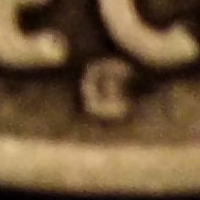
A closer look at the “inverted” D mintmark
Adding or removing mintmarks is a common method to artificially change the value of a coin. Remove the “S” from a 1921 Walking Liberty half-dollar and watch its value raise by 300-percent. Or practice adding a “D” to a 1914 Buffalo nickel to make a 400-percent profit.
After checking several references and speaking with two dealers, I sat with a box of Buffalo nickels I have to compare the mintmarks to the one on the coin. Additionally, I consulted with the images at PCGS Photograde. After all, it could be a real, undiscovered error.
The first thing I noticed on the image and with the coins I have on hand is that the mintmark on this coin is too defined for the grade. When comparing the coin to the images on Photograde, if the coin was sent in for grading it would probably be assigned a grade of G-6 of VG-8. Because of the worn rims, this coin would not grade higher than VG-8 and could be assigned a G-4.
As I was looking at the coins, those that would grade VG-8 or lower with worn rims also had mintmarks that were almost worn into the rim. In more than a dozen examples from my box, the mintmarks on all of the low-grade coins showed the rims and mintmark worn together.
Another aspect of the mintmark that bothered me was that the “D” seemed smaller than those on the coins I was looking at. For comparison, I pulled out my album with higher grade Buffalo nickels and found that the mintmark was similar in size to those in higher grades.
-

-
According to PCGS Photograde, this 1921 Buffalo Nickel represents a VG8 grade.
-
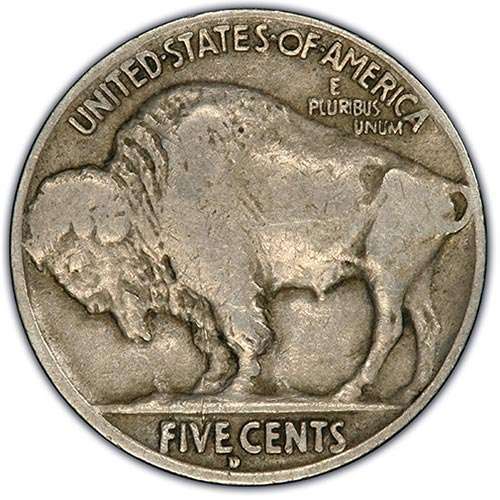
-
Look at the “D” mintmark on this 1929-D nickel graded F12 as part of PCGS Photograde
Then there is the coloring around the mintmark. Comparing it to the examples in my box, the dirt patterns around the “D” seems off. While the coloring around all of the letters appears to be uneven, there appears to be a consistent line around the “D.” In fact, the coloring at the bottom of the “D” is inconsistent with that of the other letters around it.
If I had the coin in hand, I would be able to examine it closer with a 15x loupe. I would even attempt to pick at it with a toothpick to see if the “D” would fall off. However, given all of the issues with the coin based on the images alone, I am reasonably certain that the “D” was added by someone outside of the U.S. Mint.
Of course, if you have your own theories then please post them as a comment, below.
PCGS Photograde images courtesy of PCGS and can be found
here.
Aug 2, 2018 | coins, dollar, errors, ethics, scams, US Mint, varieties
This week’s LOOK BACK is my take at the stir made over the positioning of the edge letters on the newly struck George Washington Dollar coins in 2007.
If you search the online auction sites, you will find less than honest sellers trying to sell variations in the positioning of edge lettering of the new George Washington Dollars errors or varieties. Letters that are pointed up, or the top of the letters towards the obverse, are considered “normal” by these sellers. Letters that are pointed downward, or the top of the letters closer to the reverse of the coin, have been called errors or varieties. They are neither.
Exasperating the issue is that one third-party grading service added a designation to their labels with the orientation of the edge lettering.
-
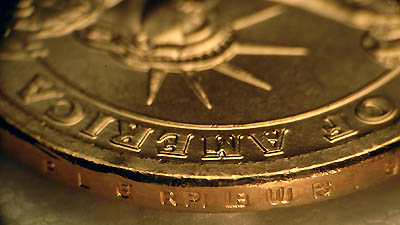
-
According to one third-party grading service, Presidential Dollars With The Tops The
Edge Lettering Facing the Reverse Are Designated As “Position A.”
-
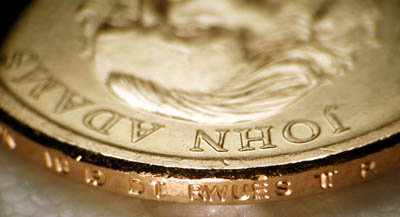
-
Those With The Tops Of Their Letters Facing The Obverse Are “Position B.”
An accepted definition of a variety “is any variation in the normal design of a given coin, usually caused by errors in the preparation or maintenance of the coin dies.” They are also errors caused in the striking process. But these definitions do not account for the differences in the orientation. The problem is that after the planchets are struck into coins by the high-speed coining machines, they are mechanically collected and fed into a machine that will press the lettering into the edge of the coins.
The machine that adds the edge lettering uses a three-part collar to impress the incuse lettering does this without regard to position. not only could the edge lettering face any direction, but the lettering can appear at any position along the edge. The U.S. Mint confirms this by saying that because of “the minting process used on the circulating coins, the edge-incused inscription positions will vary with each coin.”
Since the Mint is saying that the process can vary, these variations are normal for the design. Since these are normal variations, they are not numismatic varieties or errors. Thus, the coins with variations of orientation edge lettering are not worth the premiums being sought online. They are worth their face value of $1.
There have been errors found with the edge lettering. The most infamous has been called the “Godless Dollars” for coins missing their edge lettering and the motto “In God We Trust.” Most of these coins were minted in Philadelphia and discovered in Florida. Others have found doubling of edge letters and what looks like breaks in the three-part collars where letters have moved out of place. These are legitimate errors and worth a premium above face value. Orientation variations of the edge lettering are not errors.
If you want to consider these varieties, please save your money and visit your local bank. You can purchase these coins for face value without shipping and handling fees. If you purchase a 25-coin roll, you can spend the coins you do not want since they are legal tender.
The original article can be read
here.
Oct 12, 2017 | Britain, coins, counterfeit, errors, foreign
 As the British are winding down the use of the Round Pound, stories are once again popping up about errors of the new 12-sided pound coin being sold for high prices on eBay.
As the British are winding down the use of the Round Pound, stories are once again popping up about errors of the new 12-sided pound coin being sold for high prices on eBay.
Although the Royal Mint has admitted to manufacturing issues in trying to produce enough new pound coins to satisfy circulation requirements, their claim that the number of errors where the center are missing of the bi-metallic coins is likely post-minting errors.
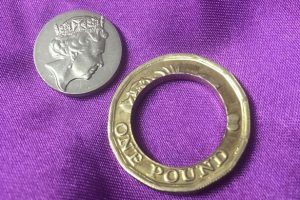
A weak strike can prevent the two metals from fusing properly allowing them to separate
To better understand why it is being claimed these are post-mint errors, I contacted a European-based dealer who has relationships with many of the continent’s mints. What follows is a summary of his explanation.
The Royal Mint coins money in a process similar to any other mint. Planchets are prepared, sent the coining press, stamped, dumped into a hopper, and sent down a conveyor where they are bagged. The bags are weight to a precise weight before the bags are accepted. Along the way, there are cameras and other sensors to detect errors.
All of the checks and sensors, including the weight of the coin, would be caught long before reaching the bagging section. Aside from the dimensions not being correct, the weight of the ring or center by themselves would not be up to the standard.
It is possible that the coins could separate in the bags during transport. However, these coins are transported to government authorized handlers. Some of them are similar to the companies that drive armored trucks here in the United States. They take the coins and prepare them for delivery to the banks.
The preparation process requires coins to be counted, rolled, and bagged. As part of the process, the coins are loaded into a system that transfers them to an automated line that brings the coins by conveyor to a machine that will either roll them or dump them in a bag. In both cases, the contents are limited by the amount they hold.
As part of the automated system, the coins are counted and check for size and weight so that if there are any coins that do not meet the Royal Mint’s standards are removed. The automated system would catch the ring and the center if they separated before the process.
Coins that are to be rolled are sent to a machine to roll them where they are counted and placed in rolls of £25 each. Those rolls are for bank and retail use and handled accordingly.
Bagged coins are used by bulk handlers such as the coin-op industry. Bags with £100 of coins are counted before being placed in the bag. If the coin cannot be verified before it is placed in the bag then the coin is rejected.
Is it possible for the coin to separate in the £100 pound bag prior to circulation? Of course, it is. However, there is one more check before the coins reach the consumer, and that is the coin-op machine itself.
Coin-op machines have mechanisms to try to prevent accepting counterfeit money and to ensure it is giving the proper change. Machines just do not eject any coin in its hopper. These checks include the weight, dimensions, and magnetic signature. The magnetic signature measures what happens after magnetic energy is flashed on the coin. Think about it as measuring how the coin would reflect light but use magnetism instead.
A pound coin that had separated would not pass the magnetic signature test and be rejected.
Although there are a number of points along the process that could fail, the number of checks between the Royal Mint and the consumer, it is highly unlikely that all of these separated pound coins exist.
It is possible that the coins being sold are from the reject bins of coin-op machines. However, the dealer I spoke with is suspicious of the number of coins being sold.

Trial strikes found without the effigy of Queen Elizabeth, II
My dealer contact said that nobody should pay more than “three-and-a-half quid” (£3.50 or $4.64 at the current exchange rate) for just a 12-sided pound outer ring. Even if it is not a legitimate Royal Mint error it is a nice conversation piece.
Examples of legitimate 12-sided £1 coin errors
-

-
Too hard of a strike is likely to have caused the copper-nickel center to melt across the coin.
-

-
First new £1 coin error found with missing detail on the thistle
Oct 5, 2017 | cents, coins, copper, errors
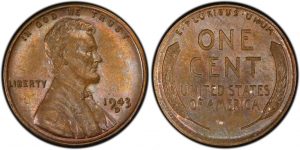
1943-D Bronze Lincoln Cent graded MS-64BN by PCGS
Raymond Reddington, played by James Spader, was trying to gain the attention of a high-rolling thief and found himself at a numismatic auction. The item up for bid was the 1943-D Bronze Lincoln cent. As part of the story, it was announced that it was the only one known to exist and that it was graded by the Professional Coin Grading Service.
Currently, there is only one known 1943-D Bronze Lincoln Cent and was graded by PCGS to be MS-64BN. It last sold for $1.7 million in 2010.
Since then, more 1943 Bronze Lincoln Cents were found including a 1943-S graded MS-62BN by PCGS. That coin was sold to Bill Simpson, a co-owner of the Texas Rangers, for $1 million in 2012. Simpson owns a complete set of 1943-PDS and 1944-PDS off-metal Lincoln cents, the latter made of zinc coated steel.
In the show, the hammer price was $3 million. All things considered, it is probably an accurate estimate of what the coin might be worth if it were to come to market today.
Of course, they did not use a real 1943-D Bronze Lincoln cent and there was a mistake when the coin showed up later in the story. But if you have not seen this episode, I am not going to spoil it for you!
Jul 13, 2017 | education, errors, US Mint, varieties
This is second article of a 2 part series:
A variety is a coin that differs from its basic design type in some distinctive way and is thus differentiated by collectors. Varieties are not errors. They are deliberate changes to the design whether it is to better define the design, adjust the design to strike better, or to add or change elements like dates and mintmarks.
A key difference between a variety and an error is that varieties are replicated for multiple strikes. Die changes, repunched mintmarks, repunched dates and over polishing of dies can reproduce the variety for the life of the die or until it is detected by Mint workers.
Nearly every series of coins has its own traceable die varieties that have been studied and catalogued by researchers. Researchers assign the varieties a number that is used by the third-party grading services to provide attribution to the variety on their holder.
-
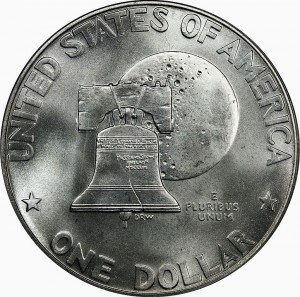
-
Bicentennial Dollar Type 1 (1975) Reverse
-

-
Bicentennial Dollar Type 2 (1976) Reverse
-
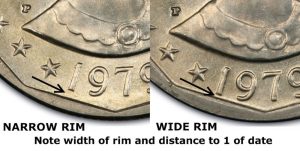
-
1979 Susan B Anthony Varieties
Variety collecting is a very specialized subject. If you are going to collect varieties, you should read the references to understand the characteristics of the varieties. Some of the more well recognized and documented varieties include:
| Catalog |
Coin Series |
Main or Initial Reference |
| Cohen (C#) |
Half Cents (1793-1857) |
American Half Cents – The “Little Half Sisters” by Roger S. Cohen, Jr. |
| Sheldon (S#) |
Large Cents (1793-1814) |
Penny Whimsy by Dr. William H. Sheldon |
| Fortin (F#) |
Liberty Seated Dimes (1837-1891) |
Liberty Seated Dimes – Die Varieties, 1837 – 1891, by Gerry Fortin |
| Overton (O#) |
Half Dollars (1794-1836) |
Early half dollar die varieties, 1794-1836, by Al C. Overton and Donald L. Parsley |
| Van Allen-Mallis (VAM#) |
Morgan and Peace Dollars (1878-1935) |
Comprehensive Catalog and Encyclopedia of Morgan & Peace Dollars, by Leroy Van Allen and A. George Mallis |
| Fivaz-Stanton (FS#) |
Varieties from the Cherrypickers’ Guide |
Cherrypickers’ Guide to Rare Die Varieties of United States Coins, by Bill Fivaz and J.T. Stanton |
Arguably, the most collected series by varieties are Morgan Dollars. VAM varieties and catalog numbers were introduced to the hobby by Leroy Van Allen and A. George Mallis who discovered the varieties while examining Morgan and Peace Dollars. Their book, Comprehensive Catalog and Encyclopedia of Morgan & Peace Dollars began a hunt that has seen hundreds of more varieties found and cataloged.
Most VAM varieties cannot be seen without magnification and detailed knowledge of what to look for. The primary resource for VAM collectors is the VAMworld website. Aside from listing the identified VAM varieties, there are instructions how to identify VAM varieties.
-
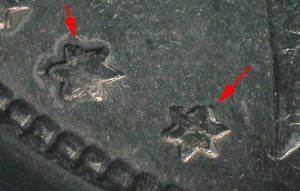
-
1878-P VAM-169 Quadrupled Stars (courtesy of VAMworld)
-
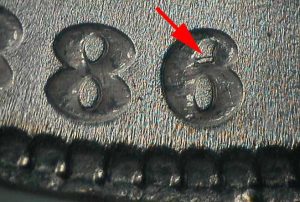
-
1886-P VAM-1A Line in 6, Slightly Doubled Ear (Image courtesy of VAMworld)
-

-
1921-S VAM-6A Doubled Stars & Motto & Upper Reverse, Die Scratch (Image courtesy of VAMworld)
The third-party grading services have an optional service that will identify VAM varieties on their holders. However, they do not recognize all VAM varieties. There are three sub-lists of catalogued VAM varieties that are recognized. These varieties are as follows:
- TOP 100: The 100 most significant VAM Varieties known
- HOT 50: A list of additional 50 VAM Varieties that collectors are interested in finding. Many of these varieties are scarce and have sold for significant premiums
- HIT LIST 40: A list of 40 new VAM Varieties that have been discovered since the publishing of the HOT 50 list
General searching for varieties and errors should consider picking up a copy of Cherrypickers’ Guide to Rare Die Varieties of United States Coins by Bill Fivaz and J.T. Stanton. The book comes in two volumes. Volume 1 covers die varieties of half cents through nickel five-cent pieces. Volume 2 covers everything else including gold and bullion issues.
Jul 12, 2017 | coins, education, errors, US Mint, varieties
This is first article of a 2 part series:

FDR dime struck on a nail (stand in for Festivus Pole)
A basic rule of thumb is that even though errors and varieties represent changes to the basic design of the coin, they differ in how they occur and the resulting appearance of the coin.
A Mint Error is the result of an issue with the manufacturing processes causing the coin to be damaged in some way. Errors can be the result in malfunction of the equipment, imperfect coining materials, or created by human error.
Even though modern equipment is supposed the make the striking process more consistent, when the manufacturing process involves striking billions of coins, there are bound to be a few errors. Coining machines have so many moving parts and everything has to work in concern, one variation in speed, force, vibration, or tilt can make the coins look very different than intended.
Then there is the human factor. Humans are imperfect beings subject to making mistakes. Even though the machines are supposed to help guide the humans to reduce mistakes, something can go wrong, especially in an operation that involves making billions of the product.
To help understand where some of the mint errors come from, they can be categorized as three different types: Planchet Errors, Die Errors, and Strike Errors.
Planchet Errors

1943 Lincoln cent struck on a copper planchet (Courtesy of CoinTrackers)
clipped planchet: Term used to describe a planchet that may have been cut incorrectly from the metal sheet. The clipped area may be curved if cut into the area where another planchet was cut out or straight if cut beyond the edge of the metal strip.
delamination: A form of planchet flaw caused by imperfections in the metal whereby a thin strip of the metal separates itself from the coin.
lamination or planchet flaw: Lamination is a type of error in the planchet that occurs when a thin layer of the metal splits or peals away from the surface of the coin.
off metal or wrong planchet: A type of error that occurs when a coin is struck on a planchet that it is not normally struck, such as striking of a quarter on a planchet that was supposed to be for a nickel.
Die Errors
A Die Error describes a defect caused by a flaw in the dies used to strike the coin. Types of Die Errors include:
cud: The area of a coin struck by a die that has a broken area across part of its surface. The result appears as a blob of metal on the surface of the coin.
die break or die crack: Fine raised lines can appear across the coin when something causes the die to break or crack. A cracked die opens a fine line in the design allowing the flow of metal to fill in the space when struck.
filled die: A type of error that appears on a coin when a foreign substance, such as grease, fills the elements of a die used to strike coins. A filled die error can also occur when the dies are polished to remove debris during the striking process. Modern minting processes have eliminated the polishing of dies but the problems with filled dies continue.
hub doubling: Refers to the doubling of the elements on a coin that was caused by the hub being pressed more than once into a die in different angles. Hub doubling occurs prior to the striking process when the dies are created. Master hubs are pressed into the dies to create working dies for the coining process. Mistakes in this process can result in the production of many coins with the error struck into them.
mule: A mule is a type of mint error that occurs when a coin is struck with two dies that were not intended to be used together.
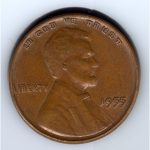
1955 DDO Lincoln Cent

1937-D 3-Legged Buffalo Nickel
The 1937-D Three-Legged Buffalo nickel occurred when a mint worker polished the reverse die of the Buffalo nickel too aggressively without checking his work. The result was the front-right leg of the buffalo being eliminated from the die. A few thousand were created before the Mint officials figured out they had a problem.
Strike Errors

Off-center 50 States quarter struck in Denver
broad strike: A coin that is struck in a way that expands beyond the boundaries of the collar. A broad strike can give the coin n flat or elongated look.
brockage: A type of striking error when the coin is not ejected properly from the press and causes the mirror image of the exposed design to be struck on the next coin.
capped die: An error in which a coin gets stuck on a die and remains stuck for successive strikes. Eventually, the coin forms a “cap” on the die and imparts its image on coins it strikes. When the cap falls off, it usually resembles a small bowl.
clashed die: One of the more interesting errors occurs when during the striking process, a malfunction prevents a planchet from being in place when the dies are forced together causing them to crash into each other. This leaves the design from either side on the other. Subsequent coins are then struck with the latent image of the other side pressed into the coin.
cracked die: An error that occurs when during the stress of striking coins, the die cracks across its face. When a cracked die strikes a coin, the metal flows into the crack that impresses a raised area in the coin that is not part of the design.
filled die: A type of error that appears on a coin when a foreign substance, such as grease, fills the elements of a die used to strike coins.
incomplete strike: A coin that is missing design detail because of a problem during the striking process.
misaligned dies: A striking error caused by one or both dies not set properly in the coining machine or worked loose during striking.
multiple-struck: A type of mint error when the coin was struck more than once. A multiple-struck coin can show the design as it is struck in multiple places.
off-center strike: During the striking process, the coin is not seated in the right place in the area over the anvil (lower) die causing the coin’s design to not be properly centered on the coin.
overstrike: A type of minting error when a coin, token or medal is struck on a previously struck coin, token or medal.
partial collar strike: A type of striking error where a planchet does not enter completely into coining position and is struck partly within the collar and partly outside.
rotated dies: A type of mint error caused by the dies not being aligned when striking the coin, token or medal.

1999-P Georgia state quarter double struck and off center.
strike doubling or doubled strike: A coin that is struck more than once while in the coining machine resulting in doubling of design elements. Double strikes are different from hub doubling in that this type of error is a mechanical failure within the coining machine whereas hub doubling happens before striking. Double strike errors are rarer than hub doubling.
weak strike: refers to a coin that does not show its intended detail because of low striking pressure or improperly aligned dies.
When going to coin shows you can see some of the most fantastic errors. Some boggle the mind how they were done and how they escaped the U.S. Mint. Dealers whose concentration are errors do not reveal their secrets but I have been told that some have contacts with some of the security companies that haul money on behalf of the banks.
This topic is not complete until we talk about varieties. That will be the next post.
Mar 19, 2017 | cents, coin design, coins, errors, US Mint
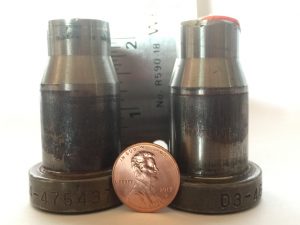
Lincoln Cent Dies from the Denver Mint
Dies from the U.S. Mint makes for an interesting collectible. Standing about 2½ inches tall and about 1¼ inches across the base where it is loaded into the coining press, it is really an unremarkable piece of metal. Weighing 192 grams (about 6.8 ounces), the only distinguishing marks on the die is the serial number stamped on the base.
Before being discarded, workers at the U.S. Mint are supposed to completely grind off the design so that it cannot be used to strike counterfeit coins. Even though it is not cost effective to flood the U.S. economy with counterfeit Lincoln cents, the U.S. Mint does not want to take the chance someone will try. Once the design is removed from the die it can become a collectible.
Close-up images of the dies make the visible design look more dramatic than in person. After all, the images were likely taken with a macro lens on a die used to strike a coin 19.05 mm (0.750 inches) in diameter. Even so, the idea was fascinating enough for me to submit bids high enough to win both dies.
The first “error” die was used to strike the obverse of 1993-D Lincoln cents. This die is not completely filed down since it does show some of Lincoln’s hair. Although not a large area, there is enough of the incuse portion of the die’s section to be able to identify it as hair and providing a good guess as to where it would be on the coin. The sticker in the image was placed there by the seller. I decided to leave the sticker.
-
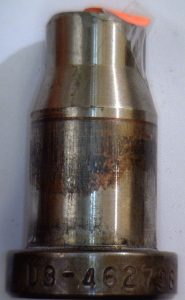
-
View of the 1993-D Lincoln Cent obverse die
-
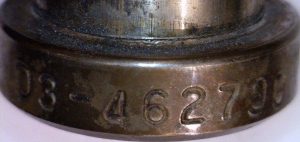
-
Serial number for the 1993-D Lincoln Cent obverse die shows the D for Denver, 3 for 1993, and followed by a sequence number
-
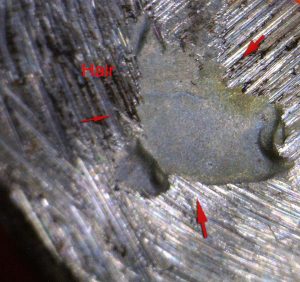
-
Close up of the 1993-D Lincoln cent die showing part of the hair design still visible.
The other error die was used to strike the reverse of 1994-D Lincoln cents. In this case, the “error” is very subtle. There are two lines that would have been where the bottom two steps of the Lincoln Memorial would have been. Based on the placement, these would be to the center-right of the Lincoln statue in the monument. In the image, it is at the bottom of the “R.” I do not know why the “CR” is written on the die but I am not removing it, for now.
-
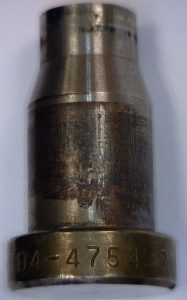
-
View of the 1994-D Lincoln Cent reverse die
-
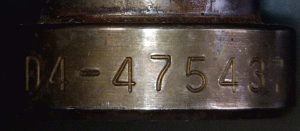
-
Serial number for the 1994-D Lincoln Cent reverse die shows the D for Denver, 4 for 1994, and followed by a sequence number
-

-
Close up of the 1994-D Lincoln cent reverse die showing a small section of the steps to the Lincoln Memorial still visible
I do not know how Fred Weinberg finds these items but they are fascinating. The next time you go to a show you should check out his inventory. He finds some really interesting errors that have to be seen to be believed.
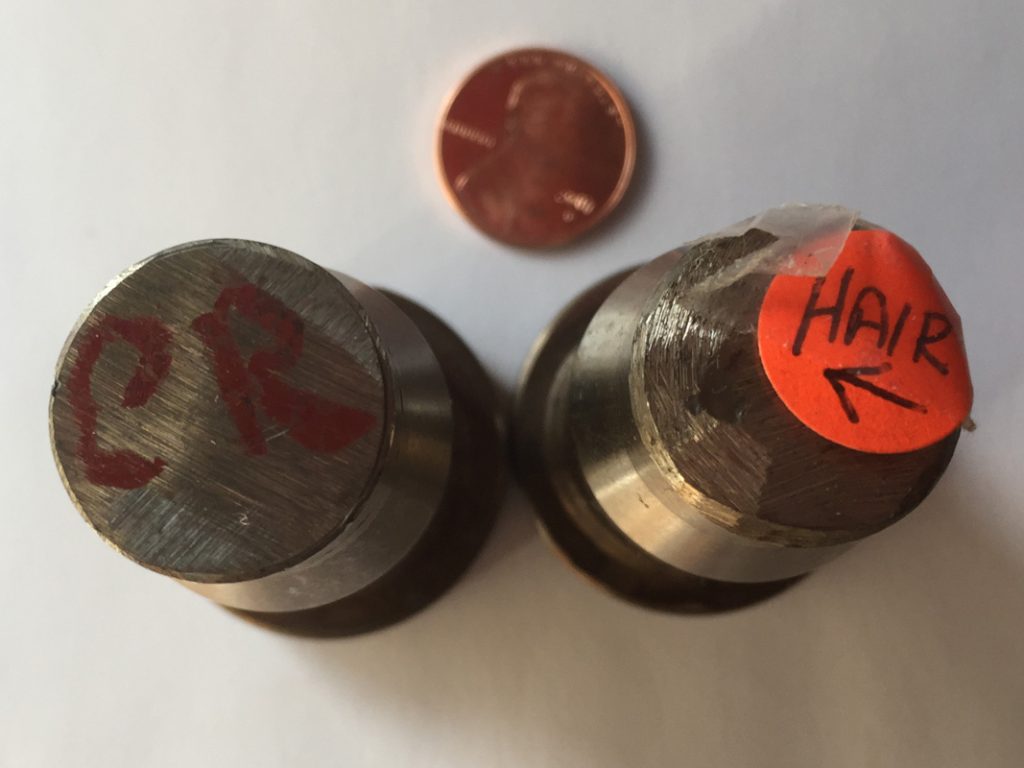
Looking down on the Lincoln Cent “error” dies. The 1994-D reverse die is on the left, The 1993-D obverse die is on the right.



 → Read more at
→ Read more at 



















